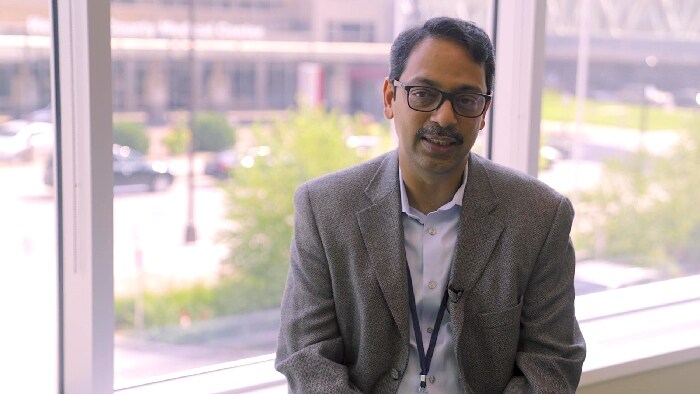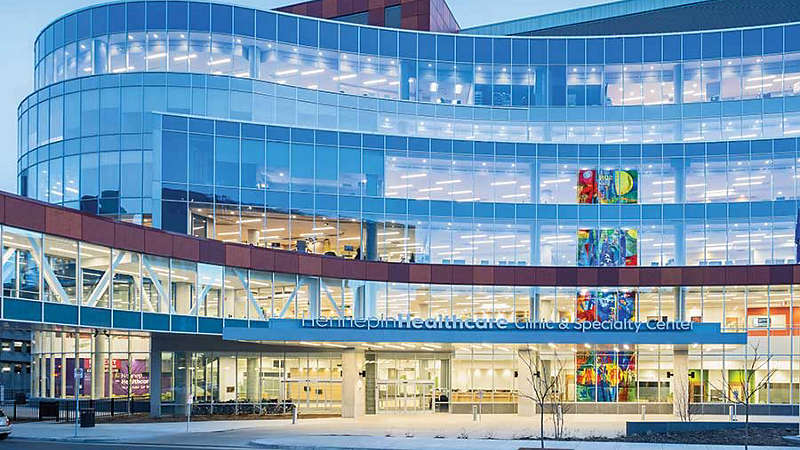Hennepin Healthcare drives clinical confidence, workflow with Spectral CT 7500
Customer story ∙ By Philips Healthcare ∙ Featuring Hennepin Healthcare, Minneapolis, MN, USA ∙ juuni 27, 2022 ∙ 7 min read
Hennepin Healthcare has experienced a substantial increase each year in CT scan volume of its most acute patients. Its healthcare system includes Hennepin County Medical Center, a Level I Adult Trauma Center and Level I Pediatric Trauma Center with the largest emergency department in Minnesota. Using the always-on spectral capability of its Philips Spectral CT 7500 system, Hennepin Healthcare has been able to increase clinical confidence, enhance patient comfort, improve technologist efficiency (including for cardiac studies) and decrease time to diagnosis.
Customer story at a glance

Dr. Gopal Punjabi, Chair of the Department of Radiology, describes the experience of Hennepin Healthcare with the Philips Spectral CT 7500.
Expanding clinical boundaries and enhancing care with spectral-detector CT at Hennepin Healthcare
Hennepin Healthcare is a comprehensive academic medical center and public teaching hospital that prides itself on its long history of supporting and investing in technology. The volume of CT scans performed for a population of extremely acute care patients has significantly increased year after year.

Hennepin Healthcare invests in technology such as the Spectral CT 7500 system to provide state-of-the-art care to patients.
When contemplating upgrading its spectral CT capabilities, the team at Hennepin Healthcare knew what it was looking for. “We really liked the ability to do spectral imaging and the ability to have spectral recons on every scan. So in other words, to have spectral imaging always on, and that was a huge advantage to us. And that was something that we wanted to have in the new scanner,” says Gopal Punjabi, MD, who is Chair of the Department of Radiology at Hennepin Healthcare. He explains, “We also wanted the scanner to be able to do cardiac scans. We wanted a large bore, faster scanner and a longer detector. I think the best combination of all those things that we were looking for was in the Spectral CT 7500.”
“The [Spectral CT] 7500 in my mind, is a spectral CT on steroids. It adds a lot of advantages to what spectral already provided us.”
Gopal Punjabi, MD Chair, Department of Radiology Hennepin Healthcare, Minneapolis, MN
The innovative features of Spectral CT 7500 have allowed Dr. Punjabi and his team to meet the dynamic needs of the healthcare system. He explains that although the decision wasn’t difficult to make, it was weighed very carefully to take into account the benefits to patients, technologists and the health system as a whole.
“As Department Chair, I’m responsible for the clinical quality of all imaging that happens. I’m responsible for protocols and policies, patient safety, to make sure that we do the right study for the right patient using the right amount of contrast and things like that. I’m responsible for recruitment and retention of radiologists. I’m responsible for budgeting for radiologists,” he summarizes.
Layers of rich spectral results with every scan, 100% of the time
“The [Spectral CT] 7500 in my mind, is a spectral CT on steroids. It adds a lot of advantages to what spectral already provided us,” says Dr. Punjabi. This detector-based spectral CT makes every scan work harder by providing layers of rich results and improving tissue characterization and visualization. Because spectral is always on, there is more information in every scan. Spectral data along with conventional CT images are sent to the PACS and then, with a single click, the user launches Magic Glass on the PACS and views a wide range of spectral images alongside conventional CT images.
“With routine CT scans, we’re used to the axial, coronal and sagittal reconstructions. We look at them, we’re done. With a spectral CT scanner, you can generate an iodine map, take the iodine out, generate the virtual non-contrast, generate different energy levels. You can do effective atomic number, calcium subtraction...all kinds of things,” says Dr. Punjabi.
The team now does advanced scanning for some of the most challenging patient types, including pediatric and bariatric, and even cardiac imaging, given the full field of view of Spectral CT 7500 and its ability to reduce calcium blooming in coronary arteries.
Diagnostic confidence in every scan that helps decrease time to diagnosis
In a clinical study, Spectral CT 7500 has shown to reduce the need for follow-up scans due to incomplete diagnosis by 26% compared to conventional CT scans in certain cases [1]. Dr. Punjabi has noticed increased diagnostic certainty first-hand. The ability to have spectral results directly on the PACS has allowed the radiology team to give a confident answer right away.
“Before, for example, with a small sub-segmental pulmonary emboli, we would hem and haw. Maybe there is one, maybe there isn’t one. Now [with the CT 7500], I call the pulmonologist and I tell them, ‘There’s a PE, 100%.’ Increasing that level of confidence I think is a big, big plus,” says Dr. Punjabi.
Faster time to diagnosis, enhancing patient care
The increased clinical certainty that Spectral CT 7500 provides goes hand in hand with a reduced time to diagnosis. In a clinical study, routine scans with detector-based spectral CT have helped physicians achieve 34% shorter time to diagnosis, compared to conventional CT scans in certain cases [2]. Dr. Punjabi and his team see that their decreased time to diagnosis helps them to deliver enhanced care.
“We’re [able to focus] on what’s really important to the patient. We’re focusing on what is probably making them sick and what is most likely to get them better, instead of focusing on a lot of the incidental stuff. So that is a big plus,” he says.
Dr. Punjabi explains that with Spectral CT 7500, he is now able to do an entire chest, abdomen and pelvis CT scan in two seconds. With speed comes improved workflow, especially for Hennepin Healthcare’s technologists.
“I think this is the technology of the future. It really lets us focus on what’s important and lets us give a diagnosis with a much higher degree of confidence. This is the whole reason why I’m a radiologist: to be able to provide a clinical diagnosis [the] first time [with] high confidence.”
Gopal Punjabi, MD Chair, Department of Radiology Hennepin Healthcare, Minneapolis, MN
Simplifying and enhancing workflow with spectral-detector CT
With the always-on layers of spectral information in every scan, the need for rescanning is greatly reduced. Scott Morgan, a technologist at Hennepin Healthcare, says, “With all the spectral information given, the doctors have a lot more information to go through and see. Say that somebody has a pulmonary embolism. On a regular scanner, they would just see that contrast. With [the 7500], they can pull a lot of the spectral data to see something that may be missed on a non-spectral scanner.”
Dr. Punjabi says that using Spectral CT 7500 has considerably reduced technologist time. Features such as Magic Glass eliminate the need to go to a separate workstation to launch spectral capabilities, saving precious time per scan. He explains that this is important because technologists are already stressed for time and their jobs are incredibly challenging every day and every single hour.
“Everything is an emergency and everything needs to be done right away. And that brings with it tremendous pressure while at the same time trying to do the right thing for every patient. So the margin for error here is minuscule,” says Dr. Punjabi. “I think this is the technology of the future. It really lets us focus on what’s important and lets us give a diagnosis with a much higher degree of confidence. This is the whole reason why I’m a radiologist: to be able to provide a clinical diagnosis [the] first time [with] high confidence,” he says.
The advantages of Spectral CT 7500 extend beyond clinicians and technologists. The system is specifically designed to accommodate a variety of patients and provide a better imaging experience comfortably.
A fast, more comfortable scan and the opportunity to reduce the use of contrast
One of the major advantages of spectral CT is the ability to reduce the number of acquisitions performed. Dr. Punjabi explains that they can take away a true non-contrast sequence for some indications and that multiple phases can be combined for other indications, reducing radiation dose for patients. “One thing that I’m really excited about is the ability to reduce contrast dose. I think we’ve done CT angiograms of the aorta with as little as 16 mL of contrast. And we can go a lot lower than that,” says Dr. Punjabi.
Patients at Hennepin Healthcare also appreciate the level of care made possible by use of Spectral CT 7500. David Cofman, a patient in his early 50s, has Type I diabetes. He had a cardiac incident, elevated blood pressure and chest pain. With lingering complications from COVID, he was advised by his doctor to forego a stress test in lieu of a heart scan. He says, “I live in the Western suburbs, and I chose to come to Hennepin County because I read that the technology was cutting edge and had the least amount of radiation, and that was important to me.” He says that the lower radiation dose wasn’t the only thing that gave him added peace of mind. With a larger 80 cm bore, there’s more room inside the Spectral CT 7500. “I really appreciated the larger bore and I didn’t feel confined at all,” he says. Other features that enhance patient comfort include a table that moves low enough for easy patient positioning.
With Spectral CT 7500, Hennepin Healthcare has invested in technology that allows the radiology department to stay in step with innovation to enhance employee satisfaction and continue to deliver on its mission of quality patient care.
Customer story
Expanding clinical boundaries with spectral-detector CT at Hennepin Healthcare
Subscribe to our email updates

Spectral-detector CT scanner
Footnotes
[1] Analysis by LSU, New Orleans, LA, USA. Results from Case studies are not predictive of results in other cases. Results in other cases may vary. [2] Analysis by CARTI Cancer Center, Little Rock, AR, USA. Results from Case studies are not predictive of results in other cases. Results in other cases may vary.
Disclaimer: Results are specific to the institution where they were obtained and may not reflect the results achievable at other institutions.
